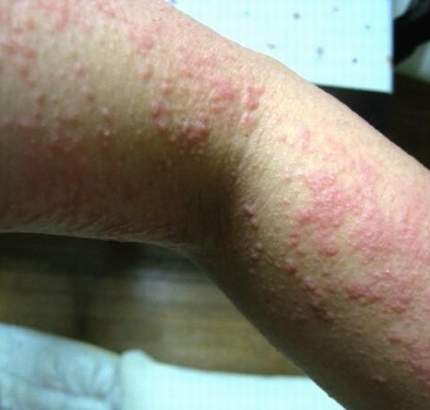What's in this article?
Cold urticaria Overview
Cold urticaria (ur-tih-KAR-e-uh) is a skin reaction to cold. Skin that has been in contact with cold develops reddish, itchy welts (hives).
The severity of cold urticaria symptoms varies widely. Some people have minor reactions to cold, while others have severe reactions. Swimming in cold water is the most common cause of a whole-body (systemic) reaction. This could lead to very low blood pressure, fainting, shock and even death.
Cold urticaria occurs most frequently in young adults. And it generally clears up within a few years. If you think you have this condition, consult your doctor. Treatment for cold urticaria usually includes taking antihistamines and avoiding cold air and water.
What causes cold urticaria?
Cold urticaria is caused by exposure to cold. Why the cold stimulus causes the activation of mast cells and subsequent release of histamine and other inflammatory mediators remains unknown.
Cold urticaria may be primary (idiopathic) or secondary to an underlying haematologic (blood condition) or infectious disease. Most cases are of the idiopathic (unknown cause) type.
Underlying conditions that have been associated with secondary cold urticaria include:
- cryoglobulinemia
- chronic lymphocytic leukaemia
- lymphosarcoma
- chickenpox (varicella)
- viral hepatitis
- infectious mononucleosis (glandular fever).
How is Cold Urticaria Diagnosed?
The diagnosis of cold urticaria is made with an ice-cube test. This test involves the placement of an ice-cube (or other cold object such as a cold freezer pack) on the forearm. The cold object is left on the arm for up to 10 minutes, with a positive test showing the appearance of a hive or swelling at the site within 5 minutes after removal of the cold object. The amount of time of exposure to the cold object that it takes can predict the severity of the disease; a positive test with shorter exposure times is associated with more severe symptoms.
Some form of cold urticaria may not have a positive ice-cube test. These include:
- Delayed cold urticaria, with symptoms occurring 12 to 48 hours after cold exposure. The ice-cube test may show a positive result many hours after placement in these people.
- Cold-dependent dermatographism, where symptoms only occur with rubbing or pressure on cold skin. The site of the ice-cube test may show a hive if rubbed with a blunt object, such as a pen.
- Cold-induced cholinergic urticaria, with symptoms usually occurring with exercise in cold environments. If symptoms also occur with exercise in warm environments, it is more likely that a person has cholinergic urticaria.
- Localized cold reflex urticaria leads to symptoms of hives and swelling away from the area of direct exposure to cold. An ice-cube test on the arm may cause hives to form a few inches away from the site of ice-cube application, for example.
- Once someone is diagnosed with cold urticaria, it may be necessary to look for underlying causes of the disease. This may include blood tests to evaluate for autoimmune diseases, cancers (such as leukemia), infections (such as mononucleosis, viral hepatitis and syphilis), as well as reviewing the medications being taken. Medications such as penicillin (and related antibiotics), birth control pills, and certain anti-fungal medications (such as griseofulvin) have been reported to cause cold urticaria.
Symptoms of cold urticaria
Cold urticaria signs and symptoms include:
- Temporary reddish, itchy welts (hives) on the area of skin that was exposed to cold
- A worsening of the reaction as the skin warms
- Swelling of hands when holding cold objects
- Swelling of lips and throat when consuming cold food or drink
Severe reactions may include:
- A whole-body response (anaphylaxis), which can cause fainting, a racing heart, swelling of limbs or torso, and shock
- Swelling of the tongue and throat, which can make it difficult to breathe
Cold urticaria symptoms begin soon after the skin is exposed to a sudden drop in air temperature or to cold water. The majority of cold urticaria reactions occur when skin is exposed to temperatures lower than 39 F (4 C). But some people can have reactions to warmer temperatures. Damp and windy conditions may make cold urticaria more likely.
The worst reactions generally occur with full skin exposure, such as swimming in cold water. Such a reaction could lead to loss of consciousness and drowning.
In some people, cold urticaria goes away on its own after weeks or months. In others, it lasts longer.
How is Cold Urticaria Treated?
Avoidance of cold environments, particularly swimming in cold water, is an important way to prevent symptoms in people with cold urticaria. Those with cold urticaria should never swim alone, given the potential for severe anaphylaxis with cold water exposure, and therefore a risk of drowning. It also may be necessary to avoid cold foods, such as ice cream and cold beverages. People with severe symptoms should carry and injectable epinephrine and wear a Medic-Alert bracelet. Symptoms may be decreased with the use of various antihistamines, particularly the older, sedating antihistamines such as cyproheptadine.





